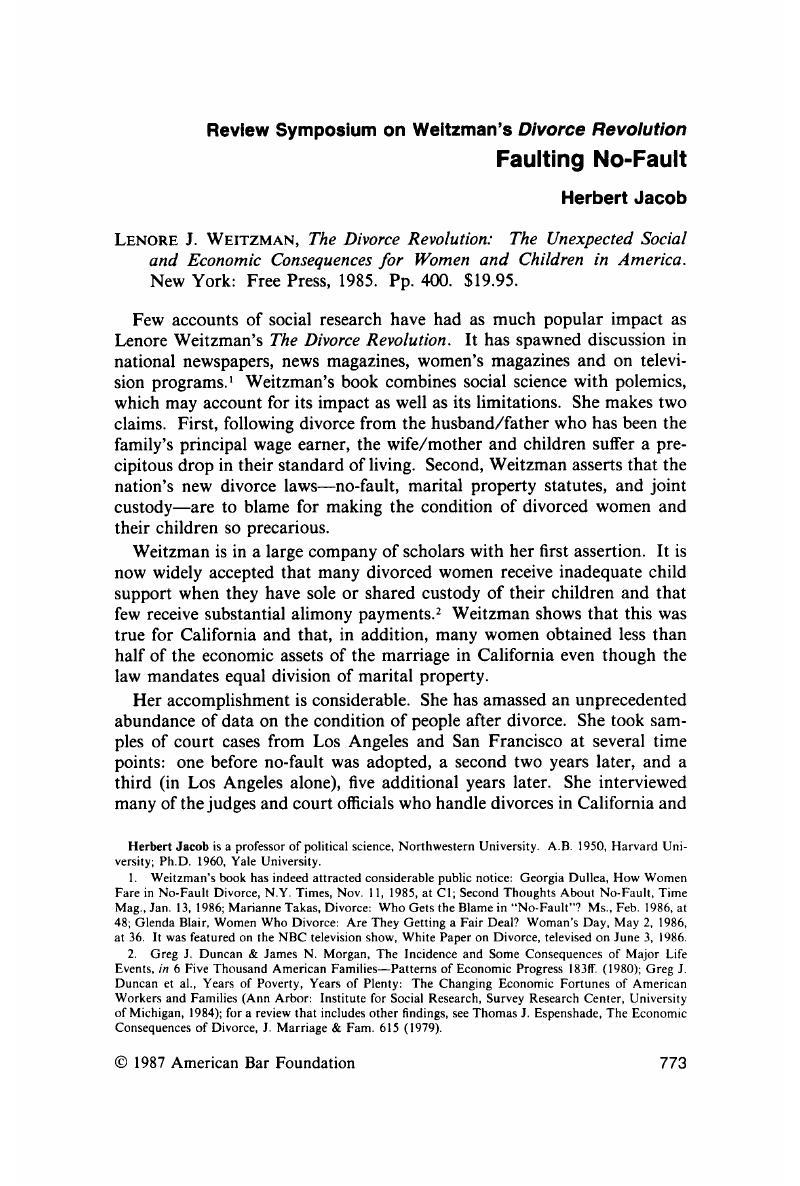Article contents
Faulting No-Fault
Review products
Published online by Cambridge University Press: 20 November 2018
Abstract

Information
- Type
- Review Symposium on Weitzman's Divorce Revolution
- Information
- Copyright
- Copyright © American Bar Foundation, 1986
References
1 Weitzman's book has indeed attracted considerable public notice: Georgia Dullea, How Women Fare in No-Fault Divorce, N.Y. Times, Nov. 11, 1985, at CI; Second Thoughts About No-Fault, Time Mag., Jan. 13, 1986; Marianne Takas, Divorce: Who Gets the Blame in “No-Fault”? Ms., Feb. 1986, at 48; Glenda Blair, Women Who Divorce: Are They Getting a Fair Deal? Woman's Day, May 2, 1986, at 36. It was featured on the NBC television show, White Paper on Divorce, televised on June 3, 1986.Google Scholar
2 Greg J. Duncan & James N. Morgan, The Incidence and Some Consequences of Major Life Events, in 6 Five Thousand American Families-Patterns of Economic Progress 183ff. (1980); Greg J. Duncan et al., Years of Poverty, Years of Plenty: The Changing Economic Fortunes of American Workers and Families (Ann Arbor: Institute for Social Research, Survey Research Center, University of Michigan, 1984); for a review that includes other findings, see Thomas J. Espenshade, The Economic Consequences of Divorce, J. Marriage & Fam. 615 (1979).Google Scholar
3 Table 22 is not entirely clear, but it appears that 11.7% of the sample in 1968 asked for sole custody in 1968, while 6.4% did so in 1977. The sample size, as reported on pp. xviii and xix, was 1,000 in 1968 and 500 in 1977.Google Scholar
4 Such temporary effects are well known; for instance, the literature on crack-downs on drunk driving shows that the effects often last for a few months and then disappear. Leon S. Robertson, Robert F. Rich, & H. Laurence Ross, Jail Sentences for Driving While Intoxicated in Chicago: A Judicial Policy That Failed, 8 Law & Soc'y Rev. 55 (1973); H. Laurence Ross, The Neutralization of Severe Penalties: Some Traffic Law Studies, 10 Law & Soc'y Rev. 403 (1976); H. Laurence Ross, Richard McCleary, & Thomas Epperlein, Deterrence of Drinking and Driving in France: An Evaluation of the Law of July 12, 1978, 16 Law & Soc'y Rev. 345 (1981–82).Google Scholar
5 The other states with the date of adoption of no-fault are Iowa (1970), Colorado (1971), Florida (1971), Michigan (1971), Oregon (1971), Kentucky (1972), Nebraska (1972), Arizona (1972), Missouri (1973), Washington (1973), Montana (1975), and Wisconsin (1977). This compilation comes from a reading of the annotated statutes of each of the 50 states and their session laws.Google Scholar
6 Cheadle, Elizabeth A., The Development of Sharing Principles in Common Law Marital Property States, U.C.L.A. L. Rev. 1269 (1981).Google Scholar
7 The five requiring equal distribution are Arkansas, California, Florida, Idaho, and Louisiana.Google Scholar
8 These are (with citations to the state's annotated statutes) Iowa (£ 598.21), Maine (tit. 19, £ 722-A), Kentucky (£ 403.190), Missouri (£ 452.330-3), North Carolina (£ 50–20), and Pennsylvania (tit. 23, £ 401).Google Scholar
9 See Campbell, Donald T. & Stanley, Julian C., Experimental and Quasi-Experimental Designs for Research (Chicago: Rand McNally, 1963); Thomas D. Cook & Donald T. Campbell, Quasi-Experimen-tation (Chicago: Rand McNally, 1979).Google Scholar
10 This statement is based on extensive personal interviews that the author has conducted with leading actors in the adoption of the 1970 no-fault law in California and an examination of surviving documents. Those results were reported briefly in Herbert Jacob, Women and Divorce Reform, in Patricia Gurin & Louis Tilley, eds., Women in Twentieth Century American Politics (New York: Russell Sage Foundation, 1988 (forthcoming)).Google Scholar
11 U.S. Bureau of the Census, Statistical Abstract of the United States, 1982–83, at 84. Note that this increase is almost exactly the same as California's increase in population. However, we do not know whether the same elements of the population continued to use divorce at the same rate under the new law as they had under the old.Google Scholar
12 Larry Bumpass & James A. Sweet, Differentials in Marital Instability: 1970, 37 Am. Soc. Rev. 754 (1972); Norval D. Glenn & Michael Supancic, The Social and Demographic Correlates of Divorce and Separation in the United States: An Update and Reconsideration, 46 J. Marriage & Fam. 563 (1984).Google Scholar
- 1
- Cited by

